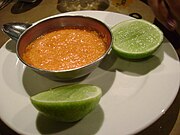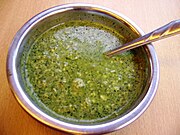
Ají (sauce)
Ají is a spicy sauce that contains ají peppers, oil, tomatoes, cilantro (coriander), garlic, onions, and water. It is served as a condiment to complement main dishes, most oftentimes in Latin American cuisines, and prepared by blending its ingredients using a food processor or blender. Although ají sauce recipes can vary from person to person, there are generally country-specific and region-specific varieties.
Description
Ají is a spicy sauce made from ají peppers that is usually served to accompany other dishes in a variety of Latin American cuisines. Its most basic ingredients include ají peppers, water, oil, garlic, cilantro, and salt. Ingredients are usually blended together using a blender or food processor. In Colombia and Ecuador, for example, food is traditionally mild, so ají can be added to almost any dish to add flavor and spice. Recipes vary dramatically from person to person and from region to region, depending on preference. Ají has been prepared in Andean countries such as Bolivia, Colombia, and Peru since at least the time of the Incas, who called it uchu. It is usually added to other foods such as anticuchos, chugchucaras, soup, chorizo, or empanadas.
The core ingredient of ají sauce, ají peppers (Capsicum Baccatum), was originally grown in South America. While these peppers have a Scoville Heat Unit of 30,000 - 50,000, depending on the variety of pepper and preparation technique, the spice level of ají sauce is variable.
Varieties
Chile
In Chile there is a similar variety of the condiment known as ají chileno, which contains the additional ingredient of lemon juice.
Ecuador
In Ecuador, ají sauce is prepared using one of the over 30 ají pepper varieties available in the country. These ají peppers vary in spice level and this, combined with the amount of water used to dilute the sauce, can create variation in the level of spice between sauces. Some regions are also known for their addition of fruits, in addition to the basic ingredients, which leads to further variety of the sauce within the country.
North West Amazonia
A variety of ají sauce called ají negro (also called Ommaï, Kígai, Do-Hmepa, Ualako) is made by the indigenous peoples of the North West Amazonia. This variety is prepared using the juice of bitter manioc.
Peru
Peru is known for a variety of ají sauce called ají amarillo sauce. This variety uses ají amarillo and is notable for its yellow color. Ají amarillo is used widely across Peru as an addition to sauces. The spice level of ají amarillo is compatible to serrano peppers registering at 15,000 on Scoville Heat Unit Scale, although sometimes registering at 30,000 to 50,000 SHU. Oftentimes this variety of ají sauce is mixed with mayonnaise, crema, or sour cream to accompany potatoes, sandwiches, meat, and ceviche.
Puerto Rico
Puerto Rico has a variety of ají sauce called ajilimojili. This variety uses aji dulce peppers and is notable for its green color.
United States
In the United States, several pre-prepared varieties of ají sauce, including aji rocoto hot sauce and aji amarillo sauce, can be purchased in Latin American markets or specialty food stores. The pepper required for some varieties of ají sauce, including that of the Peruvian ají amarillo sauce, is not grown commercially in the United States.
Gallery
See also
External links
| Chili sauce |
|
|||
|---|---|---|---|---|
| Chili paste | ||||
| Sauces |
|
|
|---|---|---|
| Dips | ||
| Pickles and preserves |
||
| Spreads and pastes | ||
| Oils and liquids | ||
| Spices and powders | ||
| Salads | ||
| Dressings | ||
| Ketchups | ||
| Mustards | ||
| Vinegars | ||
| List articles | ||
| Accoutrements | ||





